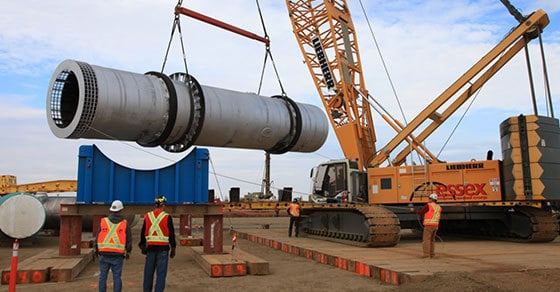Rotary drum dryers are an essential production tool in a variety of industrial settings. From ore drying to fertilizer and soil amendment production, rotary dryers are used to process thousands of tons of material each and every day throughout nearly every industry imaginable.
While the drum dryer’s high rate of reliability makes the need for replacement infrequent, when a dryer reaches its end of life, there are several aspects that deserve careful consideration for a seamless replacement.
Plan Ahead
The single most important (and most overlooked) consideration in rotary dryer replacement is to plan ahead. Operators may be lulled into a false sense of security because the dryer has continued to operate reliably for decades, but given that the dryer plays such a critical role in the production line, when the unit goes down, often the entire operation is held hostage.
Operators and plant managers should instead take a proactive approach to dryer replacement in order to avoid a catastrophic failure and extended shutdown.
Signs That A Drum Dryer Should Be Replaced
Many issues operators encounter with drum dryers are repairable, from damaged tires and trunnions to worn flights (lifters). To avoid an unplanned shutdown due to failure, operators should be on the lookout for several signs that the dryer is beyond its useful life. Signs that a dryer is reaching end of life include:
- Cracks in the shell
- Thin spots or holes in the shell
- Shell fatigue or warping
Replacement Considerations
When the time comes, the following considerations should be factored in to the dryer replacement process.
Failure Analysis
When a rotary dryer fails, and particularly when failure is unexpected or seemingly premature, a failure analysis should be conducted. Many OEMs will conduct an analysis as part of a process or equipment audit to determine how and why the unit failed. Knowing the ultimate cause of failure can be a valuable tool in preventing future issues and improving upon the design of the existing unit. For example, if the shell corroded through, it may be advisable to utilize a stronger, more corrosion-resistant material for shell construction.
Selecting a Vendor
Rotary dryer operators are often faced with the task of selecting a new vendor for replacement (often dryers last so long that the original manufacturer has since gone out of business). The process of choosing a rotary drum dryer manufacturer requires a careful evaluation of many factors in order to select a vendor that can not only provide a well-manufactured dryer, but that can also meet the unique criteria necessary to reach an efficient drying solution.
Data Required for Dryer Replacement
The data required varies based on the specific goals of the project. When an identical unit is the goal, original drawings provide many of the necessary details. When the unit will be tasked with something new, or there will be a change in the process, dryer feasibility testing may be necessary.
Apart from the drum dimensions, as well as spatial requirements, various process and product data points will be required. This typically includes:
Material Details:
- Feed rate
- Moisture content
- Chemical composition
- Temperature
- Bulk density
- Heat capacity
- Particle size distribution
- Foreign matter content
- Nature of feed
Product Details:
- Product rate
- Particle size distribution
- Moisture content
Process Details:
- Maximum allowable temperature
- Total retention time required
- Heat source
Depending on the manufacturer, there may be an opportunity to improve upon the original design, even if no changes in the process parameters have since occurred. Drum dryer design has significantly improved over the years, particularly in relation to mechanical components. By reviewing historical data and running rotary dryer sizing and process calculations, engineers may be able to optimize the design for greater efficiency, or even utilize a smaller unit to reach the same capacity.
Replacement Logistics
As a large piece of equipment, replacing a rotary dryer is also a matter of logistics. While there are many site- and project-specific factors to consider, the following considerations are generally applicable in every case.
Spatial Constraints & Building Modifications
Surrounding production equipment will need to be removed to make room for taking out the old unit and bringing in the new one. Modifications to the building such as temporary openings in the roof or sidewall may be required in order to physically get the new unit in when a large enough door is not available.
Component Reuse
In select cases, it may be an option to salvage some of the existing drum components for use with the new unit, thereby reducing the overall cost of the new drum. Though this is worth consideration when applicable, the costs and benefits must be weighed against the initial savings, as there are often challenges associated with component reuse.
Storage
Depending on production schedules, lead time on the new equipment, and other factors, the timelines may not always align so that the new unit can directly replace the old one. If this is the case, storage accommodations will be required for the new unit.
Conclusion
There are many important considerations that must be taken into account during the replacement of a rotary drum dryer, from recognizing when replacement is necessary, to improving on the design and preparing the site. Since the dryer is an essential component in the production line, replacement is better approached proactively to avoid an unexpected catastrophic failure and extended downtime.
FEECO is the leading provider of custom rotary dryers and dryer services, covering everything from inspection to feasibility testing, design improvements, manufacturing, and parts and service support. For more information on rotary dryer replacement, contact us today!



